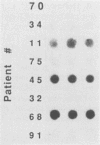Abstract
As an alternative to microscopic identification of Entamoeba histolytica parasites isolated from stool, a sensitive and species-specific DNA hybridization probe was made for rapid diagnosis of E. histolytica parasites in clinical samples directly applied to nylon membranes. The DNA hybridization probe was made by screening a genomic library of a virulent HM-1:IMSS strain of E. histolytica to detect recombinant plasmids containing highly repeated parasite DNA sequences. Four plasmid clones that reacted across Entamoeba species coded for highly repeated rRNA genes of E. histolytica. Four other plasmid clones were E. histolytica specific in that they bound to four axenized and nine xenic strains of E. histolytica but did not recognize closely related E. histolytica-like Laredo, Entamoeba moshkovskii, or Entamoeba invadens parasites. The diagnostic clones detected as few as eight cultured amoebae and did not distinguish between pathogenic and nonpathogenic zymodemes of E. histolytica. The diagnostic clones were sequenced and contained 145-base-pair sequences which appear to be tandemly repeated in the genome. No stable transcript which is homologous to the diagnostic DNA was detected. In a study of stool samples from Mexico City shown by microscopy to contain E. histolytica, Entamoeba coli, Giardia lamblia, Endolimax nana, Trichuris trichiuria, and Chilomastix mesnili parasites, the DNA hybridization probe demonstrated a sensitivity of 1.0 and a specificity of 0.93. We conclude that the DNA hybridization probe can be used for rapid and accurate diagnosis of E. histolytica parasites.
Full text
PDF





Images in this article
Selected References
These references are in PubMed. This may not be the complete list of references from this article.
- Allason-Jones E., Mindel A., Sargeaunt P., Williams P. Entamoeba histolytica as a commensal intestinal parasite in homosexual men. N Engl J Med. 1986 Aug 7;315(6):353–356. doi: 10.1056/NEJM198608073150603. [DOI] [PubMed] [Google Scholar]
- Anand P., Malaviya B., Das P., Mateen M. A., Habibullah C. M., Das S. R. Multilayer-enzyme linked immunosorbent assay (ML-ELISA) for detection of Entamoeba histolytica trophozoite coproantigen. Immunol Invest. 1985 Oct;14(5):443–453. doi: 10.3109/08820138509047613. [DOI] [PubMed] [Google Scholar]
- BIAGI F., PORTILLA J. Comparison of methods of examining stools for parasites. Am J Trop Med Hyg. 1957 Sep;6(5):906–911. doi: 10.4269/ajtmh.1957.6.906. [DOI] [PubMed] [Google Scholar]
- Bhattacharya S., Bhattacharya A., Diamond L. S. Comparison of repeated DNA from strains of Entamoeba histolytica and other Entamoeba. Mol Biochem Parasitol. 1988 Jan 15;27(2-3):257–262. doi: 10.1016/0166-6851(88)90045-x. [DOI] [PubMed] [Google Scholar]
- Diamond L. S. A new liquid medium for xenic cultivation of Entamoeba histolytica and other lumen-dwelling protozoa. J Parasitol. 1982 Oct;68(5):958–959. [PubMed] [Google Scholar]
- Diamond L. S., Harlow D. R., Cunnick C. C. A new medium for the axenic cultivation of Entamoeba histolytica and other Entamoeba. Trans R Soc Trop Med Hyg. 1978;72(4):431–432. doi: 10.1016/0035-9203(78)90144-x. [DOI] [PubMed] [Google Scholar]
- Edman U., Meza I., Agabian N. Genomic and cDNA actin sequences from a virulent strain of Entamoeba histolytica. Proc Natl Acad Sci U S A. 1987 May;84(9):3024–3028. doi: 10.1073/pnas.84.9.3024. [DOI] [PMC free article] [PubMed] [Google Scholar]
- Feinberg A. P., Vogelstein B. A technique for radiolabeling DNA restriction endonuclease fragments to high specific activity. Anal Biochem. 1983 Jul 1;132(1):6–13. doi: 10.1016/0003-2697(83)90418-9. [DOI] [PubMed] [Google Scholar]
- Grundy M. S. Preliminary observations using a multi-layer ELISA method for the detection of Entamoeba histolytica trophozoite antigens in stool samples. Trans R Soc Trop Med Hyg. 1982;76(3):396–400. doi: 10.1016/0035-9203(82)90199-7. [DOI] [PubMed] [Google Scholar]
- Guerrant R. L. Amebiasis: introduction, current status, and research questions. Rev Infect Dis. 1986 Mar-Apr;8(2):218–227. doi: 10.1093/clinids/8.2.218. [DOI] [PubMed] [Google Scholar]
- Mirelman D., Bracha R., Chayen A., Aust-Kettis A., Diamond L. S. Entamoeba histolytica: effect of growth conditions and bacterial associates on isoenzyme patterns and virulence. Exp Parasitol. 1986 Aug;62(1):142–148. doi: 10.1016/0014-4894(86)90017-2. [DOI] [PubMed] [Google Scholar]
- Reed S. L., Curd J. G., Gigli I., Gillin F. D., Braude A. I. Activation of complement by pathogenic and nonpathogenic Entamoeba histolytica. J Immunol. 1986 Mar 15;136(6):2265–2270. [PubMed] [Google Scholar]
- Robinson G. L. The laboratory diagnosis of human parasitic amoebae. Trans R Soc Trop Med Hyg. 1968;62(2):285–294. doi: 10.1016/0035-9203(68)90170-3. [DOI] [PubMed] [Google Scholar]
- Sanger F., Nicklen S., Coulson A. R. DNA sequencing with chain-terminating inhibitors. Proc Natl Acad Sci U S A. 1977 Dec;74(12):5463–5467. doi: 10.1073/pnas.74.12.5463. [DOI] [PMC free article] [PubMed] [Google Scholar]
- Sargeaunt P. G., Williams J. E., Grene J. D. The differentiation of invasive and non-invasive Entamoeba histolytica by isoenzyme electrophoresis. Trans R Soc Trop Med Hyg. 1978;72(5):519–521. doi: 10.1016/0035-9203(78)90174-8. [DOI] [PubMed] [Google Scholar]
- Shah J. S., Karam M., Piessens W. F., Wirth D. F. Characterization of an Onchocerca-specific DNA clone from Onchocerca volvulus. Am J Trop Med Hyg. 1987 Sep;37(2):376–384. doi: 10.4269/ajtmh.1987.37.376. [DOI] [PubMed] [Google Scholar]
- Southern E. M. Detection of specific sequences among DNA fragments separated by gel electrophoresis. J Mol Biol. 1975 Nov 5;98(3):503–517. doi: 10.1016/s0022-2836(75)80083-0. [DOI] [PubMed] [Google Scholar]
- Strachan W. D., Chiodini P. L., Spice W. M., Moody A. H., Ackers J. P. Immunological differentiation of pathogenic and non-pathogenic isolates of Entamoeba histolytica. Lancet. 1988 Mar 12;1(8585):561–563. doi: 10.1016/s0140-6736(88)91355-4. [DOI] [PubMed] [Google Scholar]
- Trissl D. Immunology of Entamoeba histolytica in human and animal hosts. Rev Infect Dis. 1982 Nov-Dec;4(6):1154–1184. doi: 10.1093/clinids/4.6.1154. [DOI] [PubMed] [Google Scholar]
- Vázquezdelara-Cisneros L. G., Arroyo-Begovich A. Induction of encystation of Entamoeba invadens by removal of glucose from the culture medium. J Parasitol. 1984 Oct;70(5):629–633. [PubMed] [Google Scholar]
- Walsh J. A. Problems in recognition and diagnosis of amebiasis: estimation of the global magnitude of morbidity and mortality. Rev Infect Dis. 1986 Mar-Apr;8(2):228–238. doi: 10.1093/clinids/8.2.228. [DOI] [PubMed] [Google Scholar]







